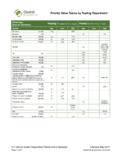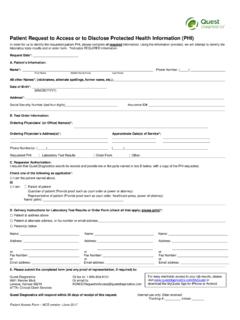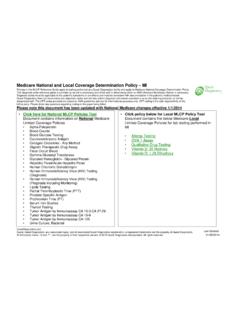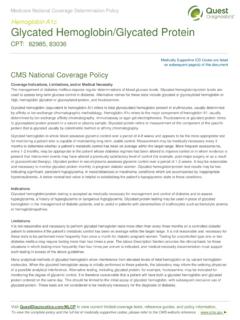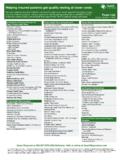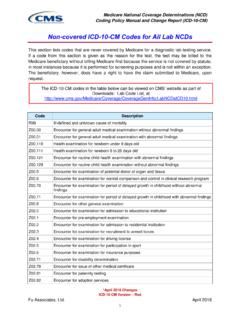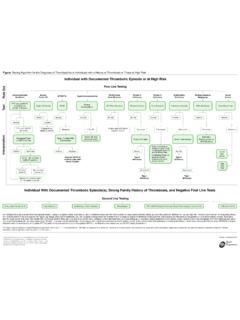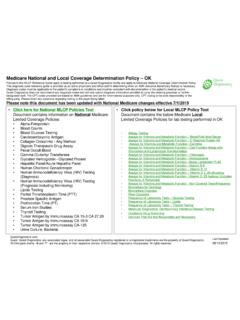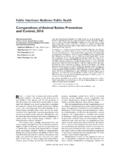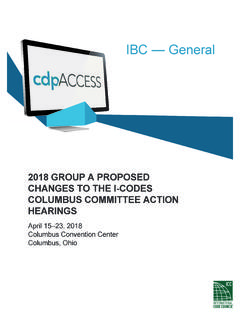Transcription of Enabling Test Compendium Efficiencies Test Compendium ...
1 Quality Lab-EHR InteroperabilityEnabling Test Compendium EfficienciesTest Compendium FrameworkElectronic Directory of Services (eDOS) A structured format for the automated delivery of Directory of Services for systems ordering lab servicesApril 2013By Ken McCaslin Director, HealthCare Standards quest diagnostics HL7 Technical Steering Committee Member HL7 Technical and Support Services Steering Division Co-Chair HL7 Orders and Observation Work Group Co-Chair American Clinical Laboratory Association s HIT Committee Chair Fellow HL7 Quality Lab-EHR InteroperabilityTable of ContentsIntroduction 3 Key concepts of the Implementation Guide 4eDOS Structure 7eDOS Advantages 9 Summary
2 11 Attachment A - HL7 News September 2011 eDOS Article * 11 Attachment B - HL7/ACLA Joint Press Release of eDOS 13 * Used by permission of Health Level Seven International. HL7 International News; Edition # September 2011; Page 16 following individuals have contributed their industry expertise to the development of this white paper:Keith Drake, Program Executive, Health IT Quality Solutions, quest DiagnosticsFreida Hall, FHL7 Manager HealthCare Standards, quest diagnostics HL7 Technical Steering Committee Member Elect HL7 Technical and Support Services Steering Division Co-Chair elect HL7 Project Services co-chair ACLA HIT Committee Member Fellow HL7 Rebecca Parsons, PMP Senior Project Manager, CIS, quest DiagnosticsPage 3 IntroductionA significant challenge in establishing a laboratory order and result interface is population of the reference laboratory s Directory of Services (DOS) within an Ordering Provider s System.
3 Historically, laboratories have provided DOS information via proprietary solutions. Until the introduction of the eDOS Implementation Guide (IG), there have been no standards for the provision of a laboratory s DOS. These solutions include both manual and electronic proprietary processes, are time consuming and costly to update the DOS for the ordering provider. The electronic transfer of laboratory order and result messages between a reference laboratory and the systems that order lab-testing services has been available for over 20 years. The ordering systems include, but are not limited to, Physician Office Systems (POS), Hospital Laboratory Information Systems (HLIS), Laboratory Information Systems (LIS), Practice Management Systems (PMS), electronic Health Records (EHR), and electronic Medical Records (EMR).
4 Here, these systems collectively will be referred to as the Ordering Provider s System. Historical Perspective and BackgroundIn 2008, the American Clinical Laboratory Association (ACLA),including over 30 participating laboratory members, tasked its Health Information Technology (HIT) Committee to create a standard for the delivery of a laboratory s DOS. Using Health Level Seven s (HL7)1 version , the HIT Committee began the development of an Implementation Guide (IG) constraining the Master File from Chapter 8 to create the framework for the test Compendium . The framework defines the fields in the Master File that will be used to message the various elements of the Directory of Services and also defines the concepts of how the content would be presented to an Ordering Provider s System.
5 This framework includes the message elements that should be presented to the clinician in order to assist in determining the appropriate test in light of a patient s diagnosis. Over 20 proposals to resolve shortcomings within the HL7 version standard were created and presented to HL7 for implementation in HL7 version For example, one of these proposals was the requirement to create separate order messages for tests with different transport temperatures or to request special handling for specimens. These proposals were then adopted early into the eDOS Implementation Guide. The Implementation Guide was opened for public comment2 before being turned over to HL7 for ballot as an ANSI Informative 1 Health Level Seven (HL7) International A standard for Clinical and administrative data 2 (2).
6 DocxPage 4 Document. The final draft of the IG was published by HL7 in January 2011 as the Implementation Guide: ACLA Test Compendium framework (eDOS), Release 1 . The final draft IG can be found at: under the section called Version Informative Documents. Please note that an HL7 membership is necessary to download the current document; or a copy can be purchased through the HL7 bookstore for $ USD. The HL7 bookstore can be found at This guide assumes HL7 knowledge and understanding of Chapter 2 conformance ACLA member laboratory informed its preferred list of vendors to begin the socialization of this new industry standard. The EHR-Lab Interoperability and Connectivity Specification (ELINCS) Order Message Implementation Guide makes reference to eDOS as a recommended solution for communicating the Directory of Services.
7 The Department of Health and Human Services Standards and Interoperability framework Initiative (S&I framework ) also has referenced eDOS3 but has not yet placed it in their list of Implementation Guides. This likely is a requirement that will be published in Meaningful Use Stage 3 (MU3) rules. MU3 proposed rules are anticipated to be published in January 2014 with final rule anticipated to be published in summer concepts of the Implementation GuideeDOS is built on HL7 version using the same message envelope used for laboratory orders and results messages, thereby allowing for existing communications to be used to exchange the DOS information. eDOS provides for initial download as well as interval maintenance updates.
8 For the purpose of this report, the identifier for a laboratory test will be called Order Codes. Order Codes can order individual tests defined as an analyte, order a battery of analytes, or order multiple tests and/or batteries that make up a profile. Examples of a battery would be an Electrolyte Panel which includes Potassium, Sodium, Chloride, and Carbon Dioxide. An example of a profile would be a Cardiac Profile that includes the Electrolyte Panel, the Cardiac Enzymes, and a number of other individual chemistry Message constructs for maintenance updatesThe message structure supports separate messages as updates, new Order Codes, and Order Code obsolescence. This allows the vendor to direct each message to the appropriate application for the task at hand.
9 3HL7 Press release for eDOS, joint with ACLA 4HL7 made no changes to chapter 8 from version through version This makes the eDOS consistent with the Implementation Guides developed by ONC for Lab Results (LRI IG) and Lab Orders (LRI IG) which are developed based on HL7 version for more details regarding these guides go to: MU3 proposed rules are anticipated to be published in January 2014 with final rule anticipated to be published in summer 5 Key data elements in eDOSThe hierarchal structure of the eDOS message allows the Ordering Provider s System to differentiate between Order Codes for a single test, battery, or profile. This structure also differentiates between orderable and non-orderable Order Codes.
10 Some Order Codes are provided in the DOS, but cannot be ordered as stand-alone tests . An example of a non-orderable Order Code is any test that can only be ordered as a reflex test. A reflex test is added by the performing laboratory when an ordered test is reported with one or more analytes that meet a specified criterion. The addition of a sensitivity panel after a microorganism has been identified is an example of a reflex test. eDOS provides for the following information: Order Code name and description List of analytes that will be reported List of information that must be provided with the order before testing can be completed by the laboratory; these are defined as Ask at Order Entry results Specimen(s) that must be collected.
